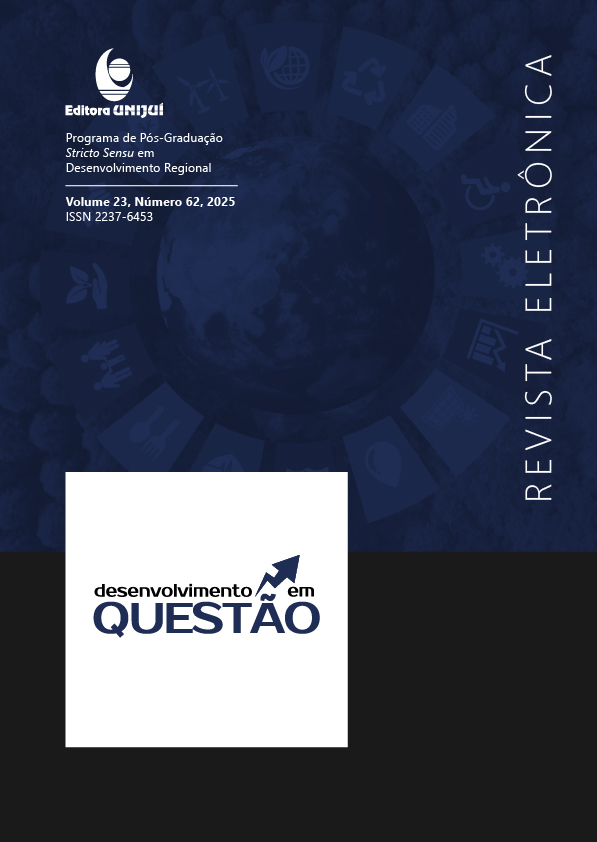Temporal and seasonal landscape diagnosis and anthropogenic impacts: Environmental assessment of a watershed using the Rapid Assessment Protocol
DOI:
https://doi.org/10.21527/2237-6453.2025.62.16186Keywords:
Rapid Assessment Protocol, Water Resources, PollutionAbstract
The growing concern about the degradation of water resources, exacerbated by climate change and accelerated urbanization, has driven institutional and legislative changes. This study aimed to evaluate streams located in the São Thomas River basin, in the municipality of Rio Verde, Goiás, Brazil, using the Rapid Assessment Protocol, highlighting the main pollution points and their characteristics to visually and landscape characterize the conditions of the streams during dry and rainy periods. Variability in water quality was observed among the sampling points, with Sapo 2, Sapo 7, and Barrinha standing out for their superior conditions, while Rocha, Buriti, and São Tomás showed less favorable conditions with higher pollution levels. Visually, variations in parameters were noted between dry and rainy periods. However, the results of the paired t-test did not indicate statistically significant differences between the dry and rainy periods (t = -2.0156, p-value = 0.0786). This suggests that, although visual indications of seasonal changes exist, the statistical evidence does not support significant differences in water quality between the analyzed periods. Therefore, while seasonal fluctuations are visually evident, the statistical analysis does not confirm their significance. These results underscore the importance of seasonal studies to understand variations in water quality over time and to support environmental management policies that promote the sustainability of water resources and ensure quality water for local communities.
References
ALVES, S. et al. Análise morfométrica da Bacia do Ribeirão das Abóboras – Rio Verde (GO). Geociências, v. 35, n. 4, p. 652-667, 2016.
BASSEY, S. A. “Anthropoholism” as an Authentic Tool For Environmental Management. International Journal of Environmental Pollution and Environmental Modelling, v. 2, n. 3, p. 160-168, 2019.
CAMPOS, J. C.; NUCCI, J. C. Protocolo de Avaliação Rápida de Rios Urbanos (PARU) como ferramenta de monitoramento ambiental. GOT: Revista de Geografia e Ordenamento do Território, v. 21, p. 121, 2021.
CLARK, R. B.; PITT, R. Water pollution control. Malden, Massachusetts, EUA: John Wiley & Sons, 2022.
DUAN, Q.; TAN, Z. Advances in water quality monitoring and assessment. São Paulo: Springer. 2018.
DUTTA, Smita; DWIVEDI, Ajay; KUMAR, M. Suresh. Use of water quality index and multivariate statistical techniques for the assessment of spatial variations in water quality of a small river. Environmental Monitoring and Assessment, [S. l.], v. 190, n. 12, p. 1-17, 13 nov. 2018.
EZE, O. et al. Spatial and Temporal Variations in Physicochemical Properties of an Aquatic Environment, Chemical Science International Journal, v. 23, n. 1, p. 1-8, 2018.
EMB. Environmental Management Bureau. Water quality monitoring manual. Department of environment and natural resources. [S. l.]: [s. n.], 2008. 231 p.
ESTEVES, F. de A. Fundamentos de limnologia. 2. ed. Rio de Janeiro: Interciência, 1998.
FELIX, R. R. de O. M.; ALVES, V.; LIMA, J. P. Gestão do uso do solo no entorno do Rio Sapucaí em Itajubá (MG). Urbe. Revista Brasileira de Gestão Urbana, v. 11, p. 1-15, 2019. DOI: https://doi.org/10.1590/2175-3369.011.001
FREIRE, L. L. Variação sazonal e interanual da qualidade das águas de rios do semiárido brasileiro. 2020. 160 f. Dissertação (Mestrado em Engenharia Civil) – Programa de Pós-Graduação em Engenharia Civil, Centro de Tecnologia, Universidade Federal do Ceará, Fortaleza, 2020.
GUPTA, Nidhi; PANDEY, Pankaj; HUSSAIN, Jakir. Effect of physicochemical and biological parameters on the quality of river water of Narmada, Madhya Pradesh, India. Water Science, v. 31, n. 1, p. 11–23, 2017. Disponível em: https://www.sciencedirect.com/science/article/pii/S1110492916300182
HERVE, M. RVAideMemoire: Testing and Plotting Procedures for Biostatistics. R package version 0.9-81-2, 2022. Disponível em: https://CRAN.R-project.org/package=RVAideMemoire
IBGE - Instituto Brasileiro de Geografia e Estatística. Rio Verde (GO) – Cidades@. 2019. Disponível em: https://cidades.ibge.gov.br/brasil/go/rio-verde.html.
R CORE TEAM. R: A language and environment for statistical computing. R Foundation for Statistical Computing. Vienna, Austria, 2023. Disponível em: URL https://www.R-project.org/
RODRIGUES, Aline Sueli de Lima; MALAFAIA, Guilherme; CASTRO, Paulo de Tarso Amorim. Protocolos de avaliação rápida de rios e a inserção da sociedade no monitoramento dos recursos hídricos. Revista Ambiente & Água, v. 3, n. 3, 2008.
RODRIGUES, Aline Sueli de Lima; CASTRO, Paulo de Tarso Amorim; MALAFAIA, Guilherme. Utilização dos protocolos de avaliação rápida de rios como instrumentos complementares na gestão de bacias hidrográficas envolvendo aspectos da geomorfologia fluvial: uma breve discussão. Enciclopédia Biosfera, v. 6, p. 1-9, 2010. Disponível em: http://www.conhecer.org.br/enciclop/2010c/utilizacao%20dos%20protocolos.pdf. Acesso em: 7 out. 2014.
RODRIGUES, A. S. L. et al. Adequação e avaliação da aplicabilidade de um Protocolo de Avaliação Rápida na bacia do Rio Gualaxo do Norte, Leste-Sudeste do Quadrilátero Ferrífero, MG, Brasil. Revista Ambiente & Água, v. 7, p. 231-244, 2012.
ROSA, C. et al. Aplicação de índices para avaliação da qualidade da água da Bacia Costeira do Sapucaia em Sergipe, Engenharia Sanitária e Ambiental, v. 23, n. 1, p. 33-46, 2017.
SANTOS, G. O. et al. Monitoramento da água em bacia hidrográfica com diferentes usos do solo no município de Rio Verde (GO). Revista em Agronegócio e Meio Ambiente, Maringá, PR, v. 12, n. 1, p. 249-271, 2019.
SHARIFINIA, Moslem; ADELI, Behzad; NAFARZADEGAN, Ali Reza. Evaluation of water quality trends in the Maroon River Basin, Iran, from 1990 to 2010 by WQI and multivariate analyses. Environmental Earth Sciences, v. 76, n. 22, p. 1-13, nov. 2017.
SMITH, Mark D.; SIKKA, A.; TINASHE, Lindel Dirwai. Research and innovation in agricultural water management for a water‐secure world. Irrigation and Drainage, 2023. DOI: https://doi.org/10.1002/ird.2872
TEGU, T. B.; EKEMUBE, R. A.; EBENEZER, S. O.; ATTA, A. T. Monitoring the Variability of the Pollutant Level in Urban Water Front during Dry and Wet Seasons. European Journal of Applied Sciences, v. 11, n. 1, p. 60–69, 2023. DOI: 10.14738/aivp.111.13747. Disponível em: https://www.journals.scholarpublishing.org/index.php/AIVP/article/view/13747
UNEP. United Nations Environment Programme. Global environment outlook 6: healthy planet, healthy people. Nairóbi, Quênia: Unop, 2018.
UNITED STATES ENVIRONMENTAL PROTECTION AGENCY. Drinking Water Regulations and Contaminants – Standards and Regulations. Washington, D.C.: USEPA, 2020. Disponível em: https://www.epa.gov/sdwa/drinking-water-regulations-and-contaminants.
VOUDRIAS, E.; ALLAN, R. Water pollution: sources, remediation and health. Boca Raton, Flórida: CRC Press, 2018.
VINÇON-LEITE, B.; SILVA, T. F. G.; GIANI, A.; FIGUEREDO, C. C.; PETRUCCI, G. Dinâmica temporal da qualidade da água em um córrego urbano tropical. Engenharia Sanitária e Ambiental, v. 26, n. 6, p. 1141–1152, 2021. Disponível em: https://www.scielo.br/j/esa/a/WyWFSqzqGPynyh8fMQshkkP/
ZAMBONI, Michelli. Avaliação do sistema fluvial urbano de Chapecó/SC através do Protocolo de Avaliação Rápida de Rios Urbanos (PARU). 2024. Dissertação (Mestrado) – Universidade Federal da Fronteira Sul, Chapecó, Erechim, 2014.
ZAMBONI, M. Aplicação do protocolo de avaliação rápida de rios como subsídio para análise da influência da urbanização no Lajeado Passo dos Índios, Chapecó/SC. 2019. 61 f. Monografia (Licenciatura em Geografia) – Universidade Federal da Fronteira Sul, Chapecó, 2019. Orientador: Andrey Luis Binda.
Downloads
Published
How to Cite
Issue
Section
License
Copyright (c) 2025 Development in Question Journal

This work is licensed under a Creative Commons Attribution 4.0 International License.
By publishing in Revista Desenvolvimento em Questão, authors agree to the following terms:
All works are published under the Creative Commons Attribution 4.0 International License (CC BY 4.0), which allows:
Sharing — to copy and redistribute the material in any medium or format;
Adaptation — to remix, transform, and build upon the material for any purpose, even commercially.
These permissions are irrevocable, provided that the following terms are respected:
Attribution — authors must be properly credited, a link to the license must be provided, and any changes made must be indicated.
No additional restrictions — no legal or technological measures may be applied that legally restrict others from doing anything the license permits.
Notices:
The license does not apply to elements that are in the public domain or covered by legal exceptions.
The license does not grant all necessary rights for specific uses (e.g., image rights, privacy, or moral rights).
The journal is not responsible for the opinions expressed in the articles, which are the sole responsibility of the authors. The Editor, with the support of the Editorial Board, reserves the right to suggest or request modifications when necessary.
Only original scientific articles presenting research results of interest that have not been previously published or simultaneously submitted to another journal with the same purpose will be accepted.
Mentions of trademarks or specific products are intended solely for identification purposes and do not imply any promotional relationship by the authors or the journal.
License Agreement (for articles published from 2025 onward): Authors retain the copyright to their article and grant Revista Desenvolvimento em Questão the right of first publication.











